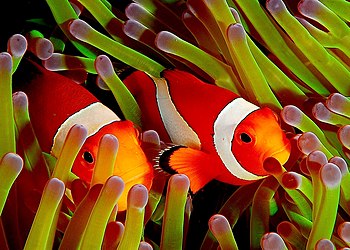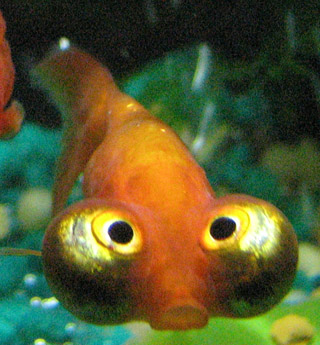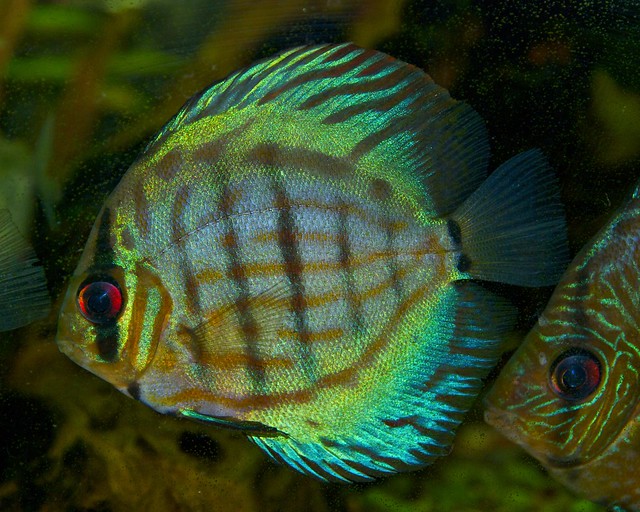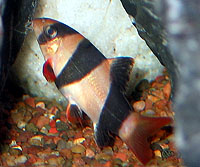 |
| Parachromis managuensis (Photo credit: Wikipedia) |
I've kept these cichlids and have nothing but good to say about them as long as you have an aquarium large enough to handle this species that grows to 55 cm/22 inches. I would say that the absolute minimum to keep these cichlids together with other cichlids is a tank of 540 litres/120 gallons. And that's a minimum; a larger aquarium is preferable. Large specimens require even larger aquariums. They can be bred in aquariums that are at least 250 litres/55 gallons.
The aquarium should be decorated so that natural territory boundaries are created and so that there are a lot of hiding places for the female, as the male can be quite mean to her if she isn't ready to breed when he is. Larger rocks should be placed directly on the bottom of the aquarium since this species digs a lot and can move large stones. Use silica to glue caves and stone formations together so that they don't fall down.
This species hasn't got any bigger demands and thrives in most water conditions as long as pH and DH levels aren't too extreme in either direction.
P. managuense can be kept with other cichlids from the region as long as they aren't too small and can stand up for themselves. This is true for most cichlids species from Central America. P. managuense can be aggressive, but in my experience, their aggressiveness is greatly exaggerated and P. managuense leaves most fishes alone. However, during breeding, they will protect their young and their territory furiously, and since they are quite large they can claim large territories especially if normal boundaries aren't created in the aquarium. But I wish to stress that P. managuense normally isn't that aggressive and doesn't beat other fish to death. Just don't keep them with fish small enough to eat (except for Ancistrus which usually survive despite their small size).
Feeding P. managuense is easy and they accept just about any food. I recommend feeding them a diet of pellets, shrimps and fish bits. To vary the diet I sometimes feed them live feeders, usually convicts since it seems that one always has spare convicts one can't get rid of by selling or giving away. I usually feed my P. managuense twice a day with the occasional week without food.
Sexing P. managuense is usually easy and follows the line of most other cichlids. Females are smaller and rounder. Breeding P. managuense is according to my experience also easy as long as you give them their own aquarium. Breeding them in aquariums with other cichlids is harder, but not too hard. The biggest problem is deciding what to do with and how to raise the very large number of fry. Each spawning can generate up to 2000-3000 fry.
They are usually very good parents and the fry grow very fast. They guard their young for up to 6 weeks during which time the fry reaches a size of 1.5 - 2 cm, or approximately ¾ inch. After that, the parents spawn again and the fry has to be removed or the parents will kill them while protecting the new batch. However, on rare occasions, the parents can protect two batches simultaneously. This usually ends in the second batch being eaten by their older sisters and brothers, which will grow very fast on this diet. :-)
Spawnings are usually 4-7 weeks apart. They usually lay their eggs on a rock or root that has been carefully cleaned, and then dig very big craters right down to the glass bottom in which to keep their young. The fry is small but accepts most kinds of food. The parents will spit out pellets that they've chewed into tiny pieces for the fry to eat. The growth rate I mentioned above is based on my own experiences when I feed only pellets. However, I don't recommend you rely too heavily on the parents chewing food for their young. You might observe whether the fry gets the food they need this way, but if they don't I recommend you feed the fry if you want them to survive.
Raising the fry without their parents is much harder and I wouldn't recommend separating fry unless it's absolutely necessary. If possible, it's better to wait a few weeks until the fry has grown a little.
If you like predatory fish and are willing to take my word that most of its reputation is undeserved, then I recommend you to try this very beautiful fish.
Article by William Berg - Article Source: EzineArticles |


















